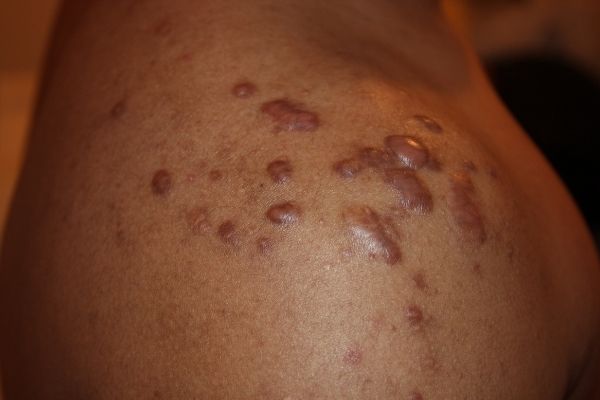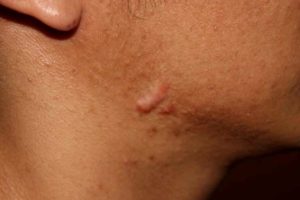Hypertrophic scars are a common side effect of acne, surgery, and other skin injuries.
They are characterized by excessive collagen production, which can result in raised and thickened skin.
While some hypertrophic scars might fade over time, most of them will remain on the skin permanently if not treated.
But luckily, there are many treatment options that can help get rid of this type of scarring.
Therefore, in this article, we will discuss the causes of hypertrophic scarring and how to treat it effectively.
What Are Hypertrophic Scars?
Hypertrophic scars are raised, thickened scars that develop when the body produces an abnormal amount of collagen tissue in an attempt to heal an injury.
Normally, a wound to the top layer of the skin would heal nicely, and besides mild hyperpigmentation that fades over time, there should be nothing left.
However, deeper wounds that go all the way down into the dermis will trigger the myofibroblasts, which are cells that produce an extracellular matrix needed to restore tissue integrity after injury, into action.
This can lead to extra tissue production, which appears on the skin as a raised, hypertrophic scar that usually looks more severe than the original injury.
What Causes Hypertrophic Scars?
While overproduction of collagen tissue is the main cause of hypertrophic scars, here are a few factors that can contribute to their development:
Severe Acne
One of the most common causes of hypertrophic scarring is severe cystic acne that goes deeper into the skin than a regular inflamed pimple.
Surgery
Hypertrophic scars can also develop after surgery, especially if the incision was done incorrectly or the wound hasn’t healed properly.
Other Skin Injuries
Burns, cuts, scratches, and deeper scrapes can all lead to hypertrophic scarring.
How do Hypertrophic Acne Scars Develop?
Acne is the immune system’s response to an overgrowth of bacteria.
When there is an overgrowth of C. acnes (the strain of bacteria that live on our skin and feed on hardened sebum inside the pores), the immune system responds by sending white blood cells to fight the infection.
The white blood cells release enzymes that break down the walls of bacteria.
However, during this process they also damage surrounding tissue, leading to inflammation and excess production of collagen tissue, which then leads to scarring.
The most common areas for acne-induced hypertrophic scars are the chest and back, where acne tends to be more severe due to the overactivity of the oil-producing glands.
However, hypertrophic acne scars can also occur on the face, but they are less common in this area.
Examples of Hypertrophic Scars

Keloids are the most severe form of a hypertrophic scar, and although the two look different, they essentially result from the same thing: abnormal production of collagen tissue in response to injury.
The difference between keloids and hypertrophic scars is their size compared to the lesions that caused them.
For example, a keloid scar is usually much larger than the lesion that caused it, while a hypertrophic scar is about the same size as the lesion that caused it.
Keloids can also change their color because the injured area sends signals to the body to direct more blood flow to the area to help the healing process.
A hypertrophic scar, on the other hand, can also change its color initially, but it usually fades over time, unlike a keloid that remains discolored.
Who is Prone to Hypertrophic Scarring?
The American Osteopathic College of Dermatology estimates that keloids affect only around 10% of people, whereas hypertrophic scars are more common.
Hypertrophic scars equally affect men and women from any racial group, although people between the ages of 10 and 30 are more likely to be affected.
This is believed to be because young people have more elasticity in their skin and produce collagen at a higher rate.
Additionally, pregnant women can also be prone to hypertrophic or keloid scarring due to abrupt hormonal changes.
How Are Hypertrophic Scars Treated?
There are various treatments that can help diminish and thoroughly get rid of hypertrophic scars.
Most of these are professional treatments performed by a dermatologist or a surgeon, so it’s definitely something that will be costly and can also take some time.
Here are the best treatments for hypertrophic scarring:
Corticosteroids
Corticosteroids are the main treatment for hypertrophic scars and involve injections into the scar to help break down and flatten the excess tissue.
Corticosteroids can also help ease pain and itching that’s sometimes experienced alongside scar formation.
However, although generally safe, corticosteroids have been linked to withdrawal symptoms and aren’t recommended during pregnancy.
Laser
Lasers primarily work by burning into the scar and flattening the elevated tissue.
Additionally, they can also target red, pink, and purple pigments in the scars and significantly lighten them after only a couple of sessions, making laser the best treatment for hypertrophic acne scarring.
Dermabrasion
Dermabrasion is a treatment performed by an esthetician or a dermatologist that involves using a special tool to remove the top layers of the skin through friction.
As the layers are removed, discoloration caused by scarring can become reduced, and the raised tissue itself can be flattened.
Cryotherapy
Cryotherapy is a procedure that uses extreme cold (liquid nitrogen) to freeze and slowly destroy elevated scar tissue, which results in flattening the scar after only a couple of treatments.
However, since cryotherapy won’t work on reddish or purple pigments, it’s unlikely to get rid of discoloration, which is why it’s best combined with other treatments such as lasers.
Bleomycin
Bleomycin is a metabolite of a strain of soil bacteria and another safe option for treating hypertrophic scarring.
The medication works by being injected directly into the scar to relieve itching and flatten the tissue overgrowth.
However, while generally safe, Bleomycin could potentially increase the chances of hyperpigmentation, especially in dark skin.
Surgery
After waiting for the scar to fully form, which usually takes a year, you can also consider surgery that involves excising the hypertrophic scar and closing it up with stitches.
This treatment aims to re-heal the injury while eliminating the issue that could’ve been responsible for causing the scar to form in the first place, such as inflammation or infection.
However, although generally safe, surgery is likely to leave minor scarring, so that’s something to keep in mind.
Can You Treat Hypertrophic Scars Naturally?
While hypertrophic scars can’t be treated naturally, some things can soften and improve them slightly.
Here are the best natural treatments for hypertrophic scarring:
Tretinoin
Tretinoin is a topical retinoid that’s commonly used to treat acne.
However, tretinoin can also help hypertrophic scars by increasing cellular turnover, which helps flatten the raised tissue by shedding excess dead skin cells faster.
Oils and Emollients
Using oils and emollients should soften hypertrophic scarring and flatten them over time.
Oils can also help strengthen the skin barrier, which means the skin will deal with inflammation better and with less severe consequences.
Some great oils you can try for hypertrophic scarring are rosehip, safflower, tamanu, squalane, and vitamin E oil.
However, avoid applying these oils on areas that are prone to acne as they could be clogging for some skin types.
Silicone Sheets
Silicone sheets can also be applied at home to help the skin heal normally after an injury.
These work best if you already know that you are prone to hypertrophic or keloid scarring and use them to prevent a scar from forming in the first place.
Many of these sheets are available over-the-counter and must be worn for 12-24 hours a day for a few months.
Lymphatic Drainage Massage
Lymphatic drainage massage is a type of gentle massage that helps improve circulation and relieve the swelling that happens when inflammation, a medical treatment, or illness is blocking the lymph nodes.
This can help hypertrophic scarring by removing toxins and driving nutrients to the area to help it heal properly.
To do this, you can either see a professional masseuse or use your fingers to very lightly massage the area in a circular motion.
Over time, lymphatic drainage massage can help weaken the scar tissue and improve the appearance of the scar.

